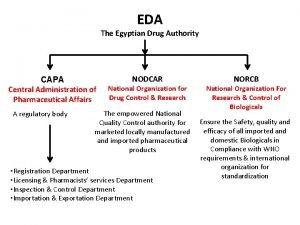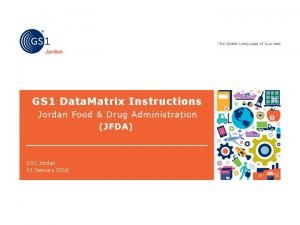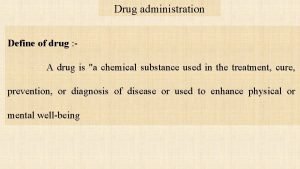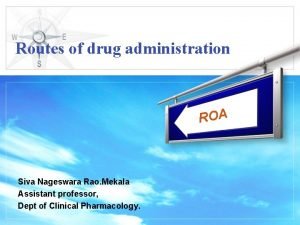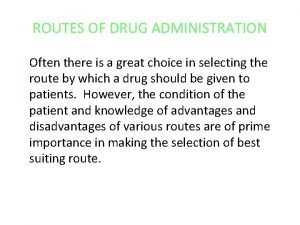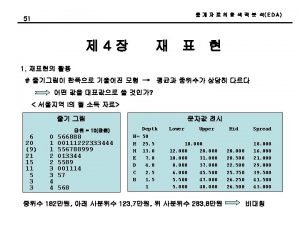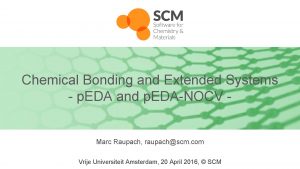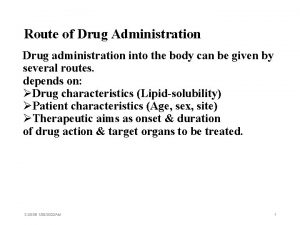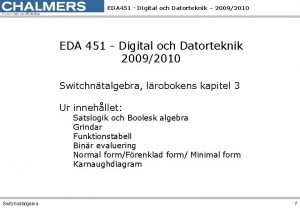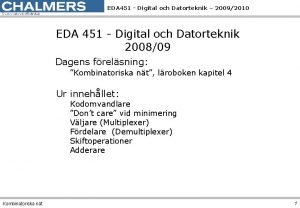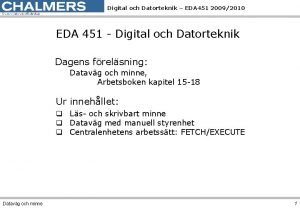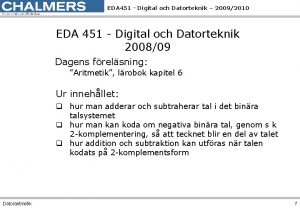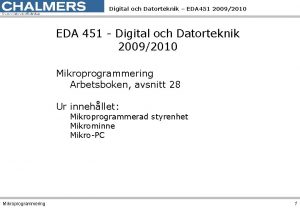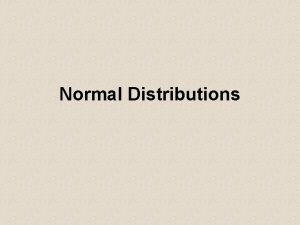EDA The Egyptian Drug Authority CAPA Central Administration



































































- Slides: 67

EDA The Egyptian Drug Authority CAPA Central Administration of Pharmaceutical Affairs A regulatory body NODCAR National Organization for Drug Control & Research The empowered National Quality Control authority for marketed locally manufactured and imported pharmaceutical products • Registration Department • Licensing & Pharmacists’ services Department • Inspection & Control Department • Importation & Exportation Department NORCB National Organization For Research & Control of Biologicals Ensure the Safety, quality and efficacy of all imported and domestic Biologicals in Compliance with WHO requirements & international organization for standardization

WHO develops and publishes guidelines, standards and recommendations that provide national authorities with the tools to develop the national medicine quality assurance system. International harmonization is one of the recent challenges of globalization.

Regional guidelines on stability testing of active substances and pharmaceutical products

These guidelines were developed during the WHO Consultation on Regional Guidelines on Stability Studies of Medicines and Biologicals, held in Jeddah in February 2006. These guidelines are based in part on existing guidelines of : • The International Conference on Harmonization of Technical Requirements for Registration of Pharmaceuticals for Human Use (ICH) • European Agency for the Evaluation of Medicinal Products • Gulf Cooperation Council.

Objective of the stability guidelines To define the stability data package for active substances (API) and finished pharmaceutical products (FPP) that is sufficient for a registration application within countries of the World Health Organization’s Eastern Mediterranean Region

Scope The guidelines address the information to be submitted in applications for registration of New Chemical Entities as well as existing active substances and their related pharmaceutical products for human use.

Definitions New Chemical Entity (NCE) An active pharmaceutical substance not previously contained in any pharmaceutical product registered with the national or regional authority concerned. A new salt, ester, or non-covalent-bond derivative of an approved active substance is considered a new molecular entity for the purpose of stability testing under this guidance. Active substance The unformulated active substance that may subsequently be formulated with excipients to produce the dosage form. Excipient Anything other than the active substance in the dosage form. Dosage form A pharmaceutical product type (e. g. tablet, capsule, solution, cream) that contains an active substance generally, but not necessarily, in association with excipients. Pharmaceutical product The dosage form in the final immediate packaging intended for marketing.

Shelf life (also referred to as expiration dating period) The time period during which a pharmaceutical product (FPP) is expected to remain within the approved shelf life specification, provided that it is stored under the conditions defined on the container label. Re-test period The period of time during which the active substance (API) is expected to remain within its specification and, therefore. For most biotechnological/biological substances known to be labile, it is more appropriate to establish a shelf life than a re-test period. The same may be true for certain antibiotics. Re-test date The date after which samples of the active substance should be examined to ensure that the material is still in compliance with the specification and thus suitable for use in the manufacture of a given pharmaceutical product.

Specification – Release The combination of physical, chemical, biological and microbiological tests and acceptance criteria that determine the suitability of a pharmaceutical product at the time of its release. Specification - Shelf life The combination of physical, chemical, biological and microbiological tests and acceptance criteria that determine the suitability of an active substance throughout its re-test period, or that a pharmaceutical product should meet throughout its shelf life.

Production batch A batch of an active substance or pharmaceutical product manufactured at production scale by using production equipment in a production facility as specified in the application. Pilot scale batch A batch of an active substance or pharmaceutical product manufactured by a procedure fully representative of and simulating that to be applied to a full production scale batch. For solid oral dosage forms, a pilot scale is generally, at a minimum, one-tenth that of a full production scale or 100 000 tablets or capsules, whichever is the larger.

Primary batch A batch of an active substance or pharmaceutical product used in a formal stability study, from which stability data are submitted in a registration application for the purpose of establishing a re-test period or shelf life, respectively. A primary batch of an active substance should be at least a pilot scale batch. For a pharmaceutical product, two of the three batches should be at least pilot scale batch, and the third batch can be smaller if it is representative with regard to the critical manufacturing steps. However, a primary batch may be a production batch. Commitment batches Production batches of an active substance or pharmaceutical product for which the stability studies are initiated or completed post approval through a commitment made in the registration application.

Formal stability studies Long-term and accelerated (and intermediate) studies undertaken on primary and/or commitment batches according to a prescribed stability protocol to establish or confirm the re-test period of an active substance or the shelf life of a pharmaceutical product. Long-term testing Stability studies under the recommended storage condition for the re-test period or shelf life proposed (or approved) for labelling. Accelerated testing Studies designed to increase the rate of chemical degradation or physical change of an active substance or pharmaceutical product by using exaggerated storage conditions as part of the formal stability studies. Data from these studies, in addition to long-term stability studies, can be used to assess longer term chemical effects at non-accelerated conditions and to evaluate the effect of short-term excursions outside the label storage conditions such as might occur during shipping. Results from accelerated testing studies are not always predictive of physical changes.

Stress testing (active substance) Studies undertaken to elucidate the intrinsic stability of the active substance. carried out under more severe conditions than those used for accelerated testing. Stress testing (pharmaceutical product) Studies undertaken to assess the effect of severe conditions on the pharmaceutical product. Such studies include photostability testing and specific testing on certain products, (e. g. metered dose inhalers, creams, emulsions, refrigerated aqueous liquid products).

Bracketing The design of a stability schedule such that only samples on the extremes of certain design factors, e. g. strength, package size, are tested at all time points as in a full design. Bracketing is applicable if the strengths are identical or very closely related in composition Bracketing can be applied to different container sizes or different fills in the same container closure system. Matrixing The design of a stability schedule such that a selected subset of the total number of possible samples for all factor combinations is tested at a specified time point. At a subsequent time point, another subset of samples for all factor combinations is tested. For example, covering different batches, different strengths, different sizes of the same container closure system, and, possibly in some cases, different container closure systems.

Container closure system The sum of packaging components that together contains and protects the dosage form. This includes primary packaging components and secondary packaging components. Impermeable containers Containers that provide a permanent barrier to the passage of gases or solvents, e. g. sealed aluminium tubes for semi-solids, sealed glass ampoules for solutions. Semi-permeable containers Containers that allow the passage of solvent, usually water, while preventing solute loss. The mechanism for solvent transport occurs by adsorption into one container surface, diffusion through the bulk of the container material, and desorption from the other surface. Examples of semi-permeable containers include plastic bags and semi-rigid, lowdensity polyethylene (LDPE) pouches for large volume parenterals (LVPs), and LDPE ampoules, bottles, and vials.

Climatic zones The four zones in the world that are distinguished by their characteristic prevalent annual climatic conditions. Mean kinetic temperature A single derived temperature that, if maintained over a defined period of time, affords the same thermal challenge to an active substance or pharmaceutical product as would be experienced over a range of both higher and lower temperatures for an equivalent defined period. The mean kinetic temperature is higher than the arithmetic mean temperature and takes into account the Arrhenius equation. Storage condition tolerances The acceptable variations in temperature and relative humidity of storage facilities formal stability studies. Short-term spikes due to opening of doors of the storage facility are accepted as unavoidable. The effect of excursions due to equipment failure should be addressed, and reported if judged to affect stability results. Excursions that exceed the defined tolerances for more than 24 hours should be described in the study report and their effect assessed.

Assignment of climatic zones and recommended storage conditions Climatic zone Definition Criteria Mean annual temperature measured in the open air/Mean annual partial water vapor pressure I Temperate climate ≤ 15 °C / ≤ 11 h. Pa 21 °C / 45% RH II Subtropical & Mediterranean climate > 15 to 22 °C / > 11 to 18 h. Pa 25 °C / 60% RH III Hot & dry climate > 22 °C / ≤ 15 h. Pa 30 °C / 35% RH IVA Hot and humid climate > 22 °C / > 15 to 27 h. Pa 30 °C / 65% RH > 22 °C / > 27 h. Pa 30 °C / 75% RH IVB Hot and very humid climate Long-term testing conditions

In order to identify adequate testing conditions, climatic zones were assigned for each country of the Eastern Region. Country Egypt CZ II + CZ III + Kuwait Saudi Arabia CZ IVA + Recommended Long-term testing conditions 30 °C/65% RH** + 30 °C/65% RH** Libyan Arab + (+) 25 °C/60% RH** Syrian Arab + (+) 25 °C/60% RH Yemen + + 30 °C/65% RH Test results conducted at higher temperatures and humilities, e. g. at 30 °C/75% RH, should be acceptable for all countries.

General principles The purpose of stability testing is to provide evidence on how the quality of an active substance or pharmaceutical product varies with time under the influence of a variety of environmental factors such as temperature, humidity and light.

General principles Study product-related factors influence the stability: • the chemical and physical properties of the active substance • the pharmaceutical excipients • the dosage form and its composition • The manufacturing process • the nature of the container-closure system, • the properties of the packaging materials

General principles As a result of stability testing, a re-test period for the API (in exceptional cases, e. g. for unstable APIs, a shelflife is given) or a shelf-life for the FPP can be established and storage conditions can be recommended.

Stability Study Guidelines Active substances Pharmaceutical products

Active substances Not described in an Described in an official pharmacopoeial monograph, monograph but a re-test period is not defined stability studies ARE required The manufacturer of the pharmaceutical product confirms that the API complies with the pharmacopoeial monograph immediately prior to the manufacture Described in an official pharmacopoeial monograph stability studies NOT required, Stability data from the manufacturer should be submitted, e. g. Drug Master File, or a European Certificate of Suitability. The manufacturer establishes a re-test period based on the results of longterm testing stability studies

Degradation products API is described in an official pharmacopoeial monograph (impurities) No extra data are required on the degradation products API is Not described in an official pharmacopoeial monograph Provide published literature if available Stress testing should be performed • Studying the effect of temperatures above that for accelerated testing (in 10 °C increments e. g. 50 °C, 60 °C, etc. ) and humidity (e. g. 75% or greater). • Oxidation and photolysis on the active substance • Susceptibility of the API to hydrolysis across a wide range of p. H (solution or suspension). • Photostability testing

Degradation products API is described in an official pharmacopoeial monograph (impurities) No extra data are required on the degradation products API is Not described in an official pharmacopoeial monograph Provide published literature if available Stress testing aims to: Determining degradation products Establishing degradation pathways Establishing the intrinsic stability of the molecule Developing and validating suitable analytical procedures. Stress testing should be performed

Selection of batches At least 3 primary batches of the active substance. The batches should be manufactured to a minimum of pilot scale by the same synthetic route as, and using a method of manufacture and procedure that simulates the final process to be used for, production batches. Container closure system The stability studies should be conducted on the active substance packaged in a container closure system that is the same as or simulates the packaging proposed for storage and distribution. Specification The testing should cover, as appropriate, the physical, chemical, biological and microbiological attributes. Validated stability-indicating analytical procedures should be applied.

Testing frequency long-term studies accelerated studies • Every 3 months over the first year • Every 6 months over the second year, • Annually thereafter A minimum of 3 time points (0, 3 and 6 months)

Storage conditions Study Storage condition Minimum time period covered by data at submission Long-term 25°C ± 2°C/60% RH ± 5% RH or 30°C ± 2°C/65% RH ± 5% RH 12 months Intermediate 30°C ± 2°C/65% RH ± 5% RH 6 months Accelerated 40°C ± 2°C/75% RH ± 5% RH 6 months

Storage conditions Active substances intended for storage in a refrigerator Minimum time period covered by data at submission Study Storage condition Long-term 5 °C ± 3°C 12 months Accelerated 25°C ± 2°C/60% RH ± 5% RH or 30°C ± 2°C/65% RH ± 5% RH 6 months • If significant change occurs between 3 and 6 months’ testing at the accelerated storage condition, the proposed re-test period should be based on the real-time data available at the long-term storage condition. • It is considered unnecessary to continue to test an active substance through six months. • A discussion should be provided to address the effect of short-term excursions outside the label storage condition, e. g. during shipping or handling.

Storage conditions Active substances intended for storage in a freezer Study Storage condition Long-term − 20 °C ± 5°C Minimum time period covered by data at submission 12 months Testing on a single batch at an elevated temperature (e. g. 5 °C ± 3 °C or 25 °C ± 2 °C or 30 °C ± 2 °C) for an appropriate time period should be conducted to address the effect of short term excursions outside the proposed label storage condition, e. g. during shipping or handling.

Storage conditions Active substances intended for storage below − 20°C should be treated on a case-by-case basis.

Stability commitment When available long-term stability data on primary batches do not cover the proposed retest period granted at the time of approval, a commitment should be made to continue the stability studies post approval in order to firmly establish the re-test period. 1. If the submission includes data from stability studies on at least three production batches, a commitment should be made to continue these studies through the proposed re-test period. 2. If the submission includes data from stability studies on fewer than three production batches, a commitment should be made to continue these studies through the proposed re-test period and to place additional production batches, to a total of at least three, on long-term stability studies through the proposed re-test period. 3. If the submission does not include stability data on production batches, a commitment should be made to place the first three production batches on long-term stability studies through the proposed re-test period.

Evaluation • Evaluating the results of stability study (physical, chemical, biological and microbiological tests) • A retest period The degree of variability of individual batches If the data shows so little degradation Statistical tests (e. g. P values for level of and so little variability, formal significance of rejection of more than 0. 25) to statistical analysis is unnecessary. the slopes of the regression lines and zero time intercepts for the individual batches. Small batch-to-batch variability Large batch-to-batch variability Overall re-test period should be based on the minimum time a batch can be expected to remain within acceptance criteria. the time at which the 95% one-sided confidence limit for the mean curve intersects the acceptance criterion. combine the data into one overall estimate

Statements/labelling • A storage statement • A re-test date • The temperature and humidity conditions during transport

Guidelines for pharmaceutical products The design of the formal stability studies for the pharmaceutical product should be based on knowledge of: -The behavior and properties of the API -Stability studies on the API -Experience gained from pre-formulation studies and investigational pharmaceutical products.

Selection of batches At least 3 primary batches of the pharmaceutical product. -Two of the three batches should be at least pilot scale batches -The primary batches should be of the same formulation and packaged in the same container closure system as proposed for marketing. -The manufacturing process used for primary batches should simulate that to be applied to production batches and should provide product of the same quality and meeting the same specification as that intended for marketing. -Batches of the pharmaceutical product should be manufactured by using different batches of the active substance. -Stability studies should be performed on each individual strength and container size of the pharmaceutical product unless bracketing or matrixing is applied.

Container closure system -Stability testing should be conducted on the dosage form packaged in the container closure system proposed for marketing (including, as appropriate, any secondary packaging and container label). -Any available studies carried out on the pharmaceutical product outside its immediate container forms a useful part of the stress testing of the dosage form -Any available studies carried out in other packaging materials can be considered as supporting information.

Specification Stability studies should include testing of those attributes of the pharmaceutical product that are susceptible to change during storage and are likely to influence quality, safety or efficacy. The testing should cover: -Physical -Chemical -Biological -Microbiological attributes -Preservative content (e. g. antioxidant, antimicrobial preservative) A single primary stability batch should be tested for antimicrobial preservative effectiveness (in addition to preservative content) at the proposed shelf life for verification purposes. Any differences between the release and shelf life acceptance criteria for antimicrobial preservative content should be supported by a validated correlation of chemical content and preservative effectiveness demonstrated during drug development on the product in its final formulation intended for marketing. -Functionality tests (e. g. for a dose delivery system).

Testing parameters Appearance, assay and degradation products should be evaluated for all dosage forms. Challenge tests for the microbial quality of multiple dose sterile and non-sterile dosage forms should carried out at least at the beginning and at the end of the shelf life. Not every listed test should be performed at each time point. -sterility testing and tests for pyrogens and bacterial endotoxins: may be conducted for most parenteral products at the beginning and at the end of the stability test period. - Microbiological testing for sterile dosage forms containing dry materials (powder filled or lyophilized products) and solutions packaged in sealed glass ampoules may need no additional beyond the initial time point.

Testing parameters 1. Tablets Appearance, assay and degradation, dissolution (or disintegration, if justified), water content and hardness/friability. 2. Capsules Hard gelatin capsules: Appearance, assay and degradation, brittleness, dissolution (or disintegration, if justified), water content and level of microbial contamination. Soft gelatin capsules: Appearance, assay and degradation, dissolution (or disintegration, if justified), level of microbial contamination, p. H, leakage, and pellicle formation. 3. Emulsions Appearance, assay and degradation, phase separation, p. H, viscosity, level of microbial contamination, and mean size and distribution of dispersed globules.

4. Oral Solutions Appearance, assay and degradation, formation of precipitate, clarity for solutions, p. H, viscosity, extractables, level of microbial contamination. Also, polymorphic conversion may be examined, if applicable. Oral Suspensions Appearance, assay and degradation, p. H, viscosity, extractables, level of microbial contamination redispersibility, rheological properties and mean size and distribution of particles 5. Powders for oral solution or suspension Appearance, assay and degradation, water content, and reconstitution time. Reconstituted products (solutions and suspensions) should be evaluated as described in “Oral Solutions and Suspensions” above, after preparation according to the recommended labelling, through the maximum intended use period.

6. Metered-dose Inhalers and Nasal Aerosols Appearance, assay and degradation, dose content uniformity, labelled number of medication actuations per container meeting dose content uniformity, aerodynamic particle size distribution, microscopic evaluation, water content, leak rate, level of microbial contamination, valve delivery (shot weight) and extractables/ leachables from plastic and elastomeric components. Samples should be stored in upright and inverted/on-the-side orientations. For suspension-type aerosols, the appearance of the valve components and container’s contents should be evaluated microscopically for large particles and changes in morphology of the drug surface particles, extent of agglomerates, crystal growth, as well as foreign particulate matter. These particles lead to clogged valves or non-reproducible delivery of a dose. Corrosion of the inside of the container or deterioration of the gaskets may adversely affect the performance of the drug product.

7. Nasal Sprays: Solutions and Suspensions Appearance, assay and degradation, clarity (for solution), level of microbial contamination, p. H, particulate matter, unit spray medication content uniformity, number of actuations meeting unit spray content uniformity per container, droplet and/or particle size distribution, weight loss, pump delivery, microscopic evaluation (for suspensions), foreign particulate matter and extractable/bleachable from plastic and elastomeric components of the container, closure and pump. 8. Suppositories Appearance, assay and degradation, Softening range, dissolution (at 37 °C). 9. Transdermal Patches Appearance, assay and degradation, In-vitro release rates, leakage, level of microbial contamination/sterility, peel and adhesive forces.

10. Topical, Ophthalmic and Otic Preparations Included in this broad category are ointments, creams, lotions, paste, gel, solutions, eye drops, and cutaneous sprays. Appearance, assay and degradation, clarity, homogeneity, p. H, resuspendability (for lotions), consistency, viscosity, particle size distribution (for suspensions, when feasible), level of microbial contamination/sterility and weight loss (when appropriate). Evaluation of ophthalmic or otic products (e. g. creams, ointments, solutions, and suspensions) should include the following additional attributes: sterility, particulate matter, and extractable. Evaluation of cutaneous sprays should include: Pressure, weight loss, net weight dispensed, delivery rate, level of microbial contamination, spray pattern, water content, and particle size distribution (for suspensions).

11. Small Volume Parenterals (SVPs) Appearance, assay and degradation, Colour, clarity (for solutions), particulate matter, p. H, sterility, endotoxins. Stability studies for powders for injection solution should include monitoring for colour, reconstitution time and water content. reconstituted drug product, stored under condition(s) recommended in labelling, clarity, colour, p. H, sterility, pyrogen /endotoxin and particulate matter. Suspension for Injection: particle size distribution, redispersibility and rheological properties. Emulsion for Injection: phase separation, viscosity, and mean size and distribution of dispersed phase globules. 12. Large Volume Parenterals (LVPs) Appearance, assay and degradation, Colour, clarity, particulate matter, p. H, sterility, pyrogen/endotoxin, and volume.

Analytical procedures should be fully validated, and stability indicating.

Testing frequency long-term studies accelerated studies • Every 3 months over the first year • Every 6 months over the second year, • Annually thereafter A minimum of 3 time points (0, 3 and 6 months) Intermediate storage studies A minimum of 4 time points (e. g. 0, 6, 9, 12 months) Reduced designs, i. e. , matrixing or bracketing, where the testing frequency is reduced or certain factor combinations are not tested at all, can be applied, if justified.

Storage conditions The storage conditions and the lengths of studies chosen should be sufficient to cover storage, shipment, and subsequent use with due regard to the climatic zone(s) in which the product is intended to be marketed. A pharmaceutical product should be evaluated under storage conditions for thermal stability and, if applicable, its sensitivity to moisture or potential for solvent loss. Photostability testing should be conducted on at least 1 primary batch of the pharmaceutical product if appropriate. Stability studies conducted on 1 batch of the pharmaceutical product for up to 3 months at 50 °C/ambient humidity may be useful to identify the formulation and packaging material adequate for extremely hot and dry conditions. Stability testing of the pharmaceutical product after constitution or dilution, if applicable

Storage conditions General case Study Storage condition Minimum time period covered by data at submission Long-term 25°C ± 2°C/60% RH ± 5% RH or 30°C ± 2°C/65% RH ± 5% RH 12 months **Intermediate 30°C ± 2°C/65% RH ± 5% RH 6 months Accelerated 40°C ± 2°C/75% RH ± 5% RH 6 months -Testing at higher humidities like 30 °C ± 2 °C/75% RH ± 5% RH is also acceptable. -If “significant change” occurs at any time during six months’ testing at the accelerated storage condition, additional testing at the intermediate storage condition should be conducted and evaluated against significant change criteria. -** If 30 °C ± 2 °C/65% RH ± 5% RH is the long-term condition, there is no intermediate condition.

“significant change” for a pharmaceutical product is defined as: 1. A 5% change in assay from its initial value; or failure to meet the acceptance criteria for potency when using biological or immunological procedures 2. Any degradation product exceeding its acceptance criterion 3. Failure to meet the acceptance criteria for appearance, physical attributes, and functionality test (e. g. colour, phase separation, resuspendibility, caking, hardness, dose delivery per actuation); however, some changes in physical attributes (e. g. softening of suppositories, melting of creams, partial loss of adhesion for transdermal products) may be expected under accelerated conditions 4. Failure to meet the acceptance criterion for p. H 5. Failure to meet the acceptance criteria for dissolution for 12 dosage units.

Special cases Storage conditions Pharmaceutical products packaged in impermeable containers Stability studies can be conducted under any controlled or ambient humidity condition

Storage conditions Special cases Aqueous-based products pharmaceutical products packaged in semi-permeable containers Appropriate information should be provided to assess the extent of water loss Studying at low relative humidity Studying under higher relative humidity and deriving the water loss at the low relative humidity through calculation. Calculate the ratio of water loss rates between the two humidity conditions at the same temperature. Experimental determination of the permeation coefficient for the container closure system Using the worst-case scenario

Storage conditions Special cases Pharmaceutical products packaged in semi-permeable containers 1. studying at the low relative humidity Study Storage condition Minimum time period covered by data at submission Long-term 25°C ± 2°C/40% RH ± 5% RH or 30°C ± 2°C/35% RH ± 5% RH 12 months **Intermediate 30°C ± 2°C/35% RH ± 5% RH 6 months Accelerated 40°C ± 2°C/ NMT 25% RH ± 5% RH 6 months A 5% loss in water from its initial value is considered a significant change after 3 months’ storage at 40 °C/NMT 25% RH. However, for small containers (1 ml or less) or unit-dose products, this may be appropriate, if justified. change in water loss alone at the accelerated storage condition does not necessitate testing at the intermediate storage condition. But data should be provided to demonstrate that the drug product would not have significant water loss throughout the proposed shelf life if

Special cases Storage conditions Pharmaceutical products packaged in semi-permeable containers 2. Calculating the ratio of water loss rates between the two humidity conditions at the same temperature. Low-humidity testing conditions Alternative testing condition Ratio of water loss rates Calculation 25 °C/40% RH 25 °C/60% RH 1. 5 (100 -40)/(100 -60) 30 °C/35% RH 30 °C/65% RH 1. 9 (100 -35)/(100 -65) 30 °C/35% RH 30 °C/75% RH 2. 6 (100 -35)/(100 -75) 40 °C/NMT 25% RH 40 °C/75% RH 3. 0 (100 -25)/(100 -75) Valid water loss rate ratios at relative humidity conditions other than those shown in the table above can also be used.

Special cases Storage conditions Active substances intended for storage in a refrigerator Minimum time period covered by data at submission Study Storage condition Long-term 5 °C ± 3°C 12 months Accelerated 25°C ± 2°C/60% RH ± 5% RH or 30°C ± 2°C/65% RH ± 5% RH 6 months • If significant change occurs between 3 and 6 months’ testing at the accelerated storage condition, the proposed shelf life period should be based on the real-time data available at the long-term storage condition. • It is considered unnecessary to continue to test an active substance through six months. • A discussion should be provided to address the effect of short-term excursions outside the label storage condition, e. g. during shipping or handling.

Special cases Storage conditions Active substances intended for storage in a freezer Study Storage condition Long-term − 20 °C ± 5°C Minimum time period covered by data at submission 12 months Testing on a single batch at an elevated temperature (e. g. 5 °C ± 3 °C or 25 °C ± 2 °C or 30 °C ± 2 °C) for an appropriate time period should be conducted to address the effect of short term excursions outside the proposed label storage condition, e. g. during shipping or handling.

Special cases Storage conditions Active substances intended for storage below − 20°C should be treated on a case-by-case basis.

Stability commitment When available long-term stability data on primary batches do not cover the proposed retest period granted at the time of approval, a commitment should be made to continue the stability studies post approval in order to firmly establish the re-test period. 1. If the submission includes data from stability studies on at least three production batches, a commitment should be made to continue these studies through the proposed re-test period. 2. If the submission includes data from stability studies on fewer than three production batches, a commitment should be made to continue these studies through the proposed re-test period and to place additional production batches, to a total of at least three, on long-term stability studies through the proposed re-test period. 3. If the submission does not include stability data on production batches, a commitment should be made to place the first three production batches on long-term stability studies through the proposed re-test period.

Evaluation • Presentation and evaluation of the results of stability study (physical, chemical, biological and microbiological tests) • A shelf life and label storage instructions applicable to all future batches The degree of variability of individual batches If the data shows so little degradation Statistical tests (e. g. P values for level of and so little variability, formal significance of rejection of more than 0. 25) to statistical analysis is unnecessary. the slopes of the regression lines and zero time intercepts for the individual batches. Small batch-to-batch variability Large batch-to-batch variability Overall re-test period should be based on the minimum time a batch can be expected to remain within acceptance criteria. the time at which the 95% one-sided confidence limit for the mean curve intersects the acceptance criterion. combine the data into one overall estimate

Evaluation Limited extrapolation of the real-time data from the long-term storage condition beyond the observed range to extent the shelf life can be undertaken, if justified. This justification should be based on: -The mechanism of degradation -The results of testing under accelerated conditions -The goodness of fit of any mathematical model -Batch size -Existence of supporting stability data. However, this extrapolation assumes that the same degradation relationship will continue to apply beyond the observed data.

Statements/labelling • A storage statement • An expiration date • If applicable, recommendations should also be made as to the utilization period and storage conditions after opening and dilution or reconstitution of a solution, e. g. an antibiotic injection supplied as a powder for reconstitution.

Statements/labelling Testing condition where the stability of the pharmaceutical product has been shown Recommended labelling statement For countries in Climatic Zones I and II: 25 °C/60% RH (long-term) 40 °C/75% RH (accelerated) “Store below 30 °C” For countries in Climatic Zones III and IVA: “Store below 30 °C” 30 °C/65% RH (long-term) 40 °C/75% RH (accelerated) For countries in Climatic Zones I and II: 25 °C/60% RH (long-term) 30 °C/65% RH (intermediate) “Store below 30 °C” For countries in Climatic Zone III and IVA: 30 °C/65% RH (long-term) “Store and transport below 30 °C” For countries in Climatic Zones I and II: 25 °C/60% RH (long-term) “Store below 25 °C” 5 °C ± 3 °C ”Store and transport in a refrigerator (2 - 8 °C)” − 20°C ± 5°C ”Store in a freezer and transport frozen (-5 -20°C)”

Statements/labelling Additional labelling statements if limiting factors are shown in the result of the stability testing demonstrate Limiting factors Additional labelling statement, where relevant Pharmaceutical products that cannot tolerate refrigerating “Do not refrigerate or freeze” Pharmaceutical products that cannot tolerate freezing “Do not freeze” Light sensitive pharmaceutical products “Protect from light” Pharmaceutical products that cannot tolerate excessive heat, e. g. suppositories “Store and transport always below 30 °C” General precautionary statements, such as “store in a dry place”, may be included, but should not be used to conceal stability problems.

In-use stability The purpose of in-use stability testing is to establish–where applicable–the period of time during which a multi-dose product can be used while retaining acceptable quality once the container is opened and the first dose is removed. • Number of batches: a minimum of 2 batches, at least pilot scale batches, should be subjected to the test. • Sampling intervals comparable to those which occur in practice, in appropriate quantities by the withdrawal methods normally used and under normal environmental conditions of use. • Physical, chemical & microbial properties susceptible to change during storage should be determined over the period of the proposed in-use shelf life.

Variations Once the pharmaceutical product has been registered, additional stability studies are required whenever major variations are made like the following: 1. Change in the manufacturing process; 2. Change in the composition of the pharmaceutical product; 3. Change of the immediate packaging. In all cases of variations, the applicant has to investigate whether the intended change will have an impact on the quality characteristics of active substances or pharmaceutical products and consequently on their stability.

Ongoing stability studies It is done after approval to monitor the product over its shelf life and to determine that the product remains, and can be expected to remain, within specifications under the labelled storage conditions. This mainly applies to: -The pharmaceutical product in the container closure system in which it is sold -Bulk products in the program. When they are stored for a long period before being packaged and/or shipped from a manufacturing site to a packaging site -Intermediates that are stored and used over prolonged periods.

Ongoing stability studies The protocol for an on-going stability programme should extend to the end of the shelf life period and should include, but not be limited to, the following parameters: • Number of batch(es) per strength and different batch sizes • Relevant physical, chemical, microbiological and biological test methods; • Acceptance criteria; • Reference to test methods; • Description of the container closure system(s); • Testing intervals (time points); • Description of the conditions of storage (standardized conditions for long-term testing as described in this guideline, and consistent with the product labelling, should be used); • Other applicable parameters specific to the pharmaceutical product.
 Capa drug
Capa drug Egyptian floral period
Egyptian floral period Line authority
Line authority Non parenteral route
Non parenteral route Jordan food and drug administration
Jordan food and drug administration Parenteral route
Parenteral route Angesid
Angesid Summary of drug administration
Summary of drug administration Factors affecting choice of route of drug administration
Factors affecting choice of route of drug administration Roa route of administration
Roa route of administration What are the different routes of drug administration
What are the different routes of drug administration Difference between oral and parenteral route
Difference between oral and parenteral route Intra arterial route advantages and disadvantages
Intra arterial route advantages and disadvantages An example of crude drug adulterated with exhausted drug
An example of crude drug adulterated with exhausted drug Central department of public administration
Central department of public administration Kinesiology ucf catalog
Kinesiology ucf catalog Suny system administration address
Suny system administration address Monetary board of the philippines
Monetary board of the philippines Müktesep arızalara örnek
Müktesep arızalara örnek Doedo doktor eda
Doedo doktor eda Eda 1
Eda 1 Eda 51
Eda 51 Lexemas morfemas
Lexemas morfemas Doedo doktor eda
Doedo doktor eda Python event driven architecture
Python event driven architecture Extrahop eda
Extrahop eda Doedo doktor eda
Doedo doktor eda Eda ines etti pikkus
Eda ines etti pikkus Eda cs
Eda cs Supraspinatus derin friksiyon masajı
Supraspinatus derin friksiyon masajı Eelstat
Eelstat Univariate eda
Univariate eda Eda.lyceum
Eda.lyceum Tracey rowan eda
Tracey rowan eda Eda kamiloğlu
Eda kamiloğlu Cyriax tekniği
Cyriax tekniği Bivariate eda
Bivariate eda Eda sas
Eda sas Eda
Eda Eda hirson
Eda hirson Eda kateter
Eda kateter Nisa eda çullas ilarslan
Nisa eda çullas ilarslan Eda mawa
Eda mawa Müstehap örnekleri
Müstehap örnekleri Doedo doktor eda
Doedo doktor eda Eda piisang
Eda piisang Eda.a
Eda.a Thế nào là sự mỏi cơ
Thế nào là sự mỏi cơ độ dài liên kết
độ dài liên kết Trời xanh đây là của chúng ta thể thơ
Trời xanh đây là của chúng ta thể thơ Chó sói
Chó sói Thiếu nhi thế giới liên hoan
Thiếu nhi thế giới liên hoan điện thế nghỉ
điện thế nghỉ Tia chieu sa te
Tia chieu sa te Một số thể thơ truyền thống
Một số thể thơ truyền thống Thế nào là hệ số cao nhất
Thế nào là hệ số cao nhất Slidetodoc
Slidetodoc Sơ đồ cơ thể người
Sơ đồ cơ thể người Số nguyên tố là gì
Số nguyên tố là gì đặc điểm cơ thể của người tối cổ
đặc điểm cơ thể của người tối cổ Cách giải mật thư tọa độ
Cách giải mật thư tọa độ Các châu lục và đại dương trên thế giới
Các châu lục và đại dương trên thế giới Tư thế worms-breton
Tư thế worms-breton ưu thế lai là gì
ưu thế lai là gì Thẻ vin
Thẻ vin Tư thế ngồi viết
Tư thế ngồi viết Cái miệng bé xinh thế chỉ nói điều hay thôi
Cái miệng bé xinh thế chỉ nói điều hay thôi Các châu lục và đại dương trên thế giới
Các châu lục và đại dương trên thế giới
